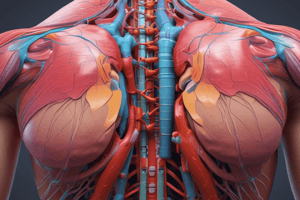Podcast
Questions and Answers
What is the primary purpose of psychological assessment, according to the information provided?
What is the primary purpose of psychological assessment, according to the information provided?
- To conduct research on the prevalence of mental disorders in the population.
- To gather data about a person and their environment in order to inform decisions about the nature, status, or treatment of psychological problems. (correct)
- To provide a detailed history of a person's life and psychological development.
- To assign individuals to specific diagnostic categories based on their symptoms.
Which of the following is NOT a goal of clinical assessment listed?
Which of the following is NOT a goal of clinical assessment listed?
- Personality profiling (correct)
- Diagnosis and treatment planning
- Screening
- Outcome evaluation
In the context of psychological testing, what does standardization refer to?
In the context of psychological testing, what does standardization refer to?
- The process of adapting a test for use with individuals from diverse cultural backgrounds.
- Ensuring that tests are administered and scored in a consistent manner across all individuals. (correct)
- Determining the statistical significance of a test's results.
- Establishing the average score on a test for a particular population.
A screening test is designed to be highly sensitive. What does this imply regarding its threshold for identifying potential issues?
A screening test is designed to be highly sensitive. What does this imply regarding its threshold for identifying potential issues?
Which of the following best describes criterion validity?
Which of the following best describes criterion validity?
Which of the following BEST describes the purpose of neuropsychological testing?
Which of the following BEST describes the purpose of neuropsychological testing?
What is a key characteristic of projective personality tests, such as the Rorschach and Thematic Apperception Test?
What is a key characteristic of projective personality tests, such as the Rorschach and Thematic Apperception Test?
How does a dimensional approach to diagnosis differ from the traditional categorical approach used in the DSM?
How does a dimensional approach to diagnosis differ from the traditional categorical approach used in the DSM?
What is the primary goal of functional analysis in behavioral assessment?
What is the primary goal of functional analysis in behavioral assessment?
What is a significant limitation of the categorical approach to diagnosis, as exemplified by the DSM?
What is a significant limitation of the categorical approach to diagnosis, as exemplified by the DSM?
Which assessment method involves individuals observing and recording their own behaviors in real-time?
Which assessment method involves individuals observing and recording their own behaviors in real-time?
What is the potential implication of comorbidity in mental health diagnoses?
What is the potential implication of comorbidity in mental health diagnoses?
Which of the following is an example of an objective personality test?
Which of the following is an example of an objective personality test?
Flashcards
Purpose of Assessment
Purpose of Assessment
To gather info about a person to guide treatment decisions.
Screening
Screening
A brief test given to everyone to identify potential issues without diagnosing.
Diagnosis and Treatment Planning
Diagnosis and Treatment Planning
The process of identifying a psychological condition to create appropriate treatment strategies.
Outcome Evaluation
Outcome Evaluation
Signup and view all the flashcards
Psychometric Properties
Psychometric Properties
Signup and view all the flashcards
Clinical Interviews
Clinical Interviews
Signup and view all the flashcards
MMPI-3
MMPI-3
Signup and view all the flashcards
Rorschach Test
Rorschach Test
Signup and view all the flashcards
General Health Questionnaire
General Health Questionnaire
Signup and view all the flashcards
Beck Depression Inventory-II
Beck Depression Inventory-II
Signup and view all the flashcards
Neuropsychological Testing
Neuropsychological Testing
Signup and view all the flashcards
Comorbidity
Comorbidity
Signup and view all the flashcards
Dimensional Systems
Dimensional Systems
Signup and view all the flashcards
Study Notes
Assessment, Diagnosis, and Treatment
- Assessment aims to gather data about a person and their environment to inform decisions regarding psychological problems.
- Assessment goals include screening, diagnosis and treatment planning, and outcome evaluation.
- Screening is given to everyone, and is designed to be sensitive but not diagnostic; follow-up is needed.
- Diagnosis facilitation communication between clinicians and researchers, and guides treatment strategies, as well as for insurance reimbursement.
- Outcome evaluation assesses treatment effectiveness through adjusting treatment length/focus, providing patient feedback and determining when clinically significant change occurs.
- Outcome evaluation is a "measurement-based care" approach.
Purpose of Assessment
- Gathering data about a person and their environment is critical to making decisions related to psychological problems.
Goals of Clinical Assessment
- Screening for potential problems.
- Developing a diagnosis and treatment plan.
- Evaluating outcomes of the treatment.
Screening
- Given to everyone.
- Designed to be sensitive (low threshold).
- Not sufficient for diagnosis.
- Requires follow-up for diagnosis.
Diagnosis and Treatment Planning
- Differential diagnosis.
- Facilitates communication with clinicians and researchers.
- Enables appropriate treatment selection.
- Supports insurance reimbursement.
Outcome Evaluation
- Assessing treatment effectiveness.
- Adjusting treatment length and focus according to progress.
- Providing feedback to patients.
- Identifying clinically significant change.
- Utilizing measurement-based care.
- Example data shown is for GAD-7, PHQ-9, social phobia, satisfaction with life, and readiness to change.
Properties of Psychological Tests
- Standardization: Tests administered identically to all participants.
- Putting test scores in context via comparison to a representative group.
- Normative comparisons.
- Reliability: test-retest consistency and inter-rater agreement.
- Validity: Construct validity and criterion/predictive validity.
- Clinical prediction less accurate than statistical prediction.
Types of Testing
- Clinical Interview (unstructured, structured).
- Psychopathology Tests (objective personality tests, measuring psychopathology; MMPI-3, PAI).
- Personality Tests (projective personality tests, e.g., Rorschach, TAT).
- Symptom Measures (general functioning, specific symptoms; e.g., Beck Anxiety Inventory, Beck Depression Inventory-II).
- Intelligence Testing (IQ based on mental age, compared to age-matched peers; used in contexts like education and dementia assessments).
- Neuropsychological Testing (assessing cognitive abilities like memory, executive functioning, attention, visuospatial functioning).
Behavioral Assessment
- Self-monitoring (patient records own behavior).
- Functional analysis (identifying causal links between behaviors and contextual factors).
Diagnosis
- Diagnostic and Statistical Manual of Mental Disorders (DSM) is used to classify abnormal behaviors and diagnose mental disorders, with the 5th edition (DSM-5) being the most recent version.
- The DSM has undergone various revisions (I-V) resulting in changing numbers of disorders over time.
Diagnostic Problems
- Comorbidity is common (half of people with one disorder have at least two).
- Diagnostic cut-offs are not empirically based.
- Symptoms presentation in individuals with the same diagnosis can vary significantly.
Dimensional Systems as an Alternative
- Disorders are viewed as extreme variations of normal experience.
- Patient functioning is assessed along dimensions (ex: disinhibition, neuroticism, social detachment).
- Strengths include better description of patient difficulties across different functioning areas, and a better understanding of patients whose symptoms do not fit any existing category.
Psychological Treatment
- Treatment decisions begin with assessment and diagnostic information.
- Therapists' theoretical orientation, current research, and general knowledge are additional factors.
- Treatment increasingly prioritizes empirically-supported, evidence-based practices.
Evaluating Treatment Options
- Therapy is generally effective.
- Different therapy types don't show substantial differences in effectiveness.
- Specific therapies or combinations may be more effective for particular problems or disorders.
Making Treatment Decisions
- Treatment decisions are based on thorough assessments and diagnostic findings.
- Therapist's theoretical orientation, research findings, and prevailing clinical knowledge significantly impact decisions.
Which factors contribute to therapy outcomes?
- Specific therapy techniques account for 15%
- Expectancy of therapy success accounts for 15%
- Client factors account for 20%
- Therapist factors account for 10%
- Common factors (e.g., client-therapist relationship) account for 10%
- Events in client's life (like social support or spontaneous improvement) account for 30%
Studying That Suits You
Use AI to generate personalized quizzes and flashcards to suit your learning preferences.




